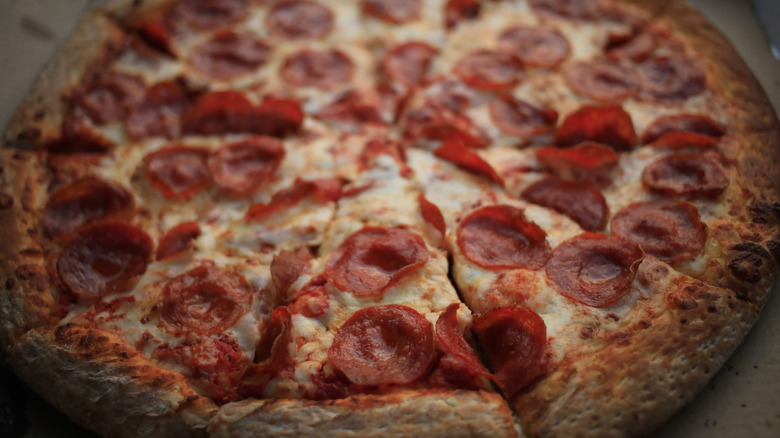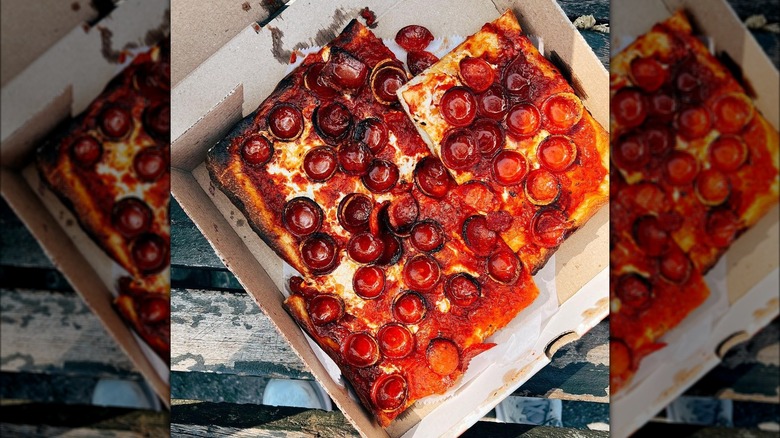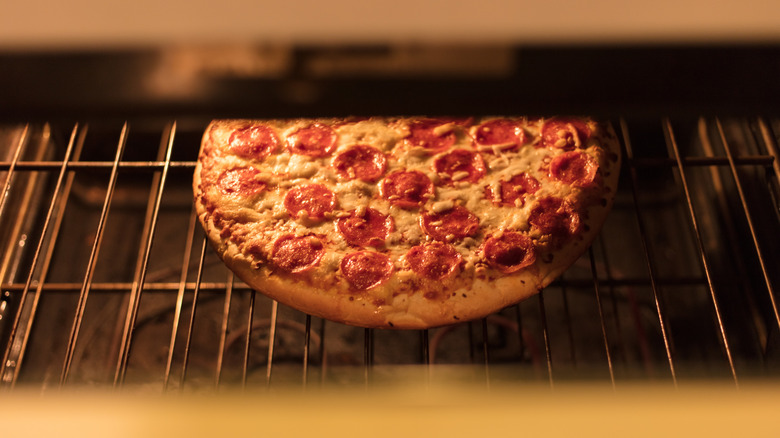The Science Behind Why Pepperoni Curls On Pizza
Have you ever grabbed a slice of pepperoni pizza, looked at the crispy curl on the edges of each piece of pepperoni, and wondered why the pepperoni curls? If you have, then you're in good company. If you haven't, well, then you're probably about to find out. What exactly is the science behind this mysterious (but undeniably delicious) phenomenon?
There are many hypotheses, and according to Serious Eats, they boil down to three main thoughts about pepperoni. Does the extent of the pepperoni curl have to do with the thickness of the pizza? Does the shrinking casing of the pepperoni as it cooks play a role in the curl? Or is it the fluid dynamics of the pepperoni stuffing that make your favorite topping curl up?
While this may sound complicated, there are some surprisingly simple answers to these questions (per Meat+Poultry). But whatever the answer, a good curl gives pepperoni its beloved taste and texture.
Three possible explanations for the pepperoni curl
There are three possible explanations for the pepperoni phenomenon, but what exactly are they? The first is that thickness matters. The top of a pepperoni pizza is exposed to the oven's air, so it heats faster than the bottom, which is buried beneath layers of delicious cheese and pepperoni. Therefore, the top cooks faster and shrinks more — and so does the pepperoni. This effect is more pronounced with a thicker pepperoni slice because there's more food between the top and bottom of the pizza, so according to this explanation, the pepperoni should be curlier when its slice is thicker (per Home Kitchen Talk).
The second hypothesis involves the pepperoni casing. There are three types of casing options: natural, collagen, and casing-free (per Slice Pizzeria). According to Meat+Poultry, when the casing is stripped off the pepperoni before the pizza cooks, the pepperoni will lie flat in the oven. But when the casing remains on the pepperoni as the pizza cooks, the casing will shrink as it cooks and therefore curl the pepperoni edges.
The third explanation is that the collagen casing doesn't stretch as much as the fiber casing, and the moisture retention of the meat being forced down to the center and sticking to the sides of the slice affects the curl pattern. This downward "meat flow" of meat and fat in the pepperoni would cause pieces to curl more with collagen casing than with fiber casing (per Meat+Poultry).
Why pepperoni curls on pizza
Keep in mind that these are just hypotheses, not set-in-stone reasons for why pepperoni curls on pizza. That said, pepperoni enthusiasts have tested out these possible explanations, and the results are fascinating. According to Home Kitchen Talk, the heat differential between the top and bottom of the pizza slice does influence the amount that pepperoni curls. In other words, pizza with thicker pepperoni slices will probably have curlier pepperoni. Thickness also dictates whether the pepperoni will curl upwards or downwards.
The way that pepperoni is stuffed into its casing also affects whether or not the pepperoni curls. Meat stuffed into natural or collagen casing — as opposed to casing-free pepperoni — will be curlier. The moisture retention of the center versus the sides of the slice also can make pepperoni curly.
What doesn't make a difference? Whether or not the pepperoni casing is removed before you pop the pizza in the oven. If you want extra-curly pepperoni, don't worry too much about the casing sitting in the oven — it won't affect the curliness of your pepperoni (per Meat+Poultry). (To recap, hypothesis number one and hypothesis number three seem to be true, while hypothesis number two doesn't hold much water.) The science behind why pepperoni curls is fascinating — and it'll give you some food for thought the next time you reach for a slice of pepperoni pizza.


